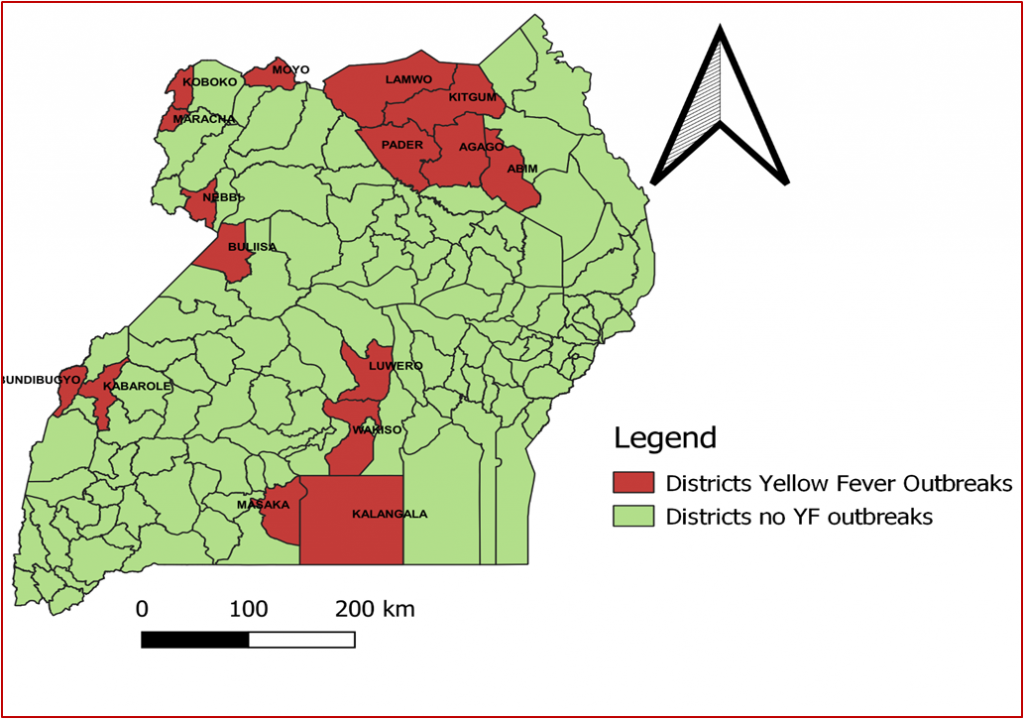By Sylivia Bwami Nandawula
Yellow fever (YF) is a viral disease transmitted by the bite of an infected mosquito. In forest areas, monkeys are the main reservoir of infection. YF is spread by mosquitoes from monkey to monkey and occasionally to humans. In urban settings, mosquitoes transmit the virus from human to human and can lead to large epidemics of yellow fever
Eradication of the disease is impossible since the YF virus is maintained within a non-human host population. YF is preventable by a single-dose vaccine and the vaccine Existed since 1938, many years ago even before the first anti-biotics were put on board.

Incubation period: The incubation period of YF disease is typically 3-6 days
Mode of Transmission
1. Jungle or Sylvatic Transmission:
- Occurs in jungle environments where multiple mosquito species (including Aedes spp.) transmit the virus between non-human primate hosts
- Humans get infected when they are bitten by mosquito species found in the forest canopy
- Humans working and having recreational activities within the jungle are at risk of acquiring the disease
2. Urban transmission
Occur when infected people introduce the virus into heavily populated areas with high density of Aedes aegypti mosquitoes and where most people have little or no immunity
In these conditions, infected mosquitoes transmit the virus from person to person
3. Intermediate transmission
- This is the most common type of outbreak in Africa.
- Occurs in smaller rural villages, where humans and monkeys live in close proximity to each other
- Infected semi-domestic and Sylvatic mosquitoes (Aedes spp.) infect both humans and monkeys
- Increased contact between people and infected mosquitoes leads to outbreaks in many separate villages in an area at the same time
Signs and Symptoms of Yellow Fever
- The first, “acute”, phase usually causes fever, muscle pain with prominent backache, headache, shivers, loss of appetite, nausea or vomiting. Most patients improve and their symptoms disappear after 3 to 4 days.
- The second, “Toxic” phase; 15% of patients enter this phase within 24 hours of the initial remission.
- High fever returns and several body systems are affected.
- The patient rapidly develops jaundice and complains of abdominal pain with vomiting.
- Bleeding from the mouth, nose, eyes or stomach. Once this happens, blood appears in the vomit, urine and faeces.
- Kidney function deteriorates.
- Half of the patients who enter the toxic phase die within 10 to 14 days, the rest recover without significant organ damage.

Management of Yellow Fever
- Encourage anyone with suspected yellow fever to seek medical care early
- Report immediately through standard surveillance mechanisms
- No specific treatments are available, however, supportive care including hydration and antibiotics to support secondary infections improves outcomes
- It is very important to ensure any patient with suspected Yellow Fever is sheltered under a treated insecticide bed-net day and night to avoid onward spread by mosquitos.
- Provide therapeutic support to the patient to manage symptoms (e.g., pain medication, IV hydration)
- Intensive care support for multi-organ failure / systemic illness
Prevention
1. Risk assessment and surveillance
- Identify populations at risk
- Detect outbreaks early
2. Vaccination and outbreak response
- Contain outbreaks through emergency response (reactive campaign)
- Prevent outbreaks through mass vaccination (preventative), which has been done.
- Protect children through routine immunization given at nine months
- Vaccination of travelers according to International Health Regulations(IHR)
3. Mosquito Control
- Eliminating potential mosquito breeding sites
- Application of spray insecticides to kill adult mosquitoes in urban settings
The writer; Sylvia Bwami Nandawula (BScN) is the In-Charge at Gombe Health Centre, in Nansana Municipality, Wakiso District
Do you have a story or an opinion to share? Email us on: dailyexpressug@gmail.com Or follow the Daily Express on X Platform or WhatsApp for the latest updates.

